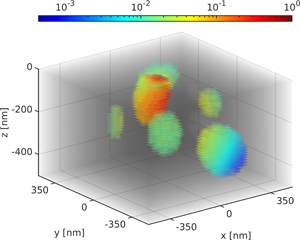Article contents
A Model for Characteristic X-Ray Emission in Electron Probe Microanalysis Based on the (Filtered) Spherical Harmonic ( $P_{\rm N}$) Method for Electron Transport
$P_{\rm N}$) Method for Electron Transport
Published online by Cambridge University Press: 11 April 2022
Abstract

Classical  $k$-ratio models, for example, ZAF and
$k$-ratio models, for example, ZAF and  $\phi ( \rho z)$, used in electron probe microanalysis (EPMA) assume a homogeneous or multilayered material structure, which essentially limits the spatial resolution of EPMA to the size of the interaction volume where characteristic X-rays are produced. We present a new model for characteristic X-ray emission that avoids assumptions on the material structure to not restrict the resolution of EPMA a priori. Our model bases on the spherical harmonic (
$\phi ( \rho z)$, used in electron probe microanalysis (EPMA) assume a homogeneous or multilayered material structure, which essentially limits the spatial resolution of EPMA to the size of the interaction volume where characteristic X-rays are produced. We present a new model for characteristic X-ray emission that avoids assumptions on the material structure to not restrict the resolution of EPMA a priori. Our model bases on the spherical harmonic ( $P_{\rm N}$) approximation of the Boltzmann equation for electron transport in continuous slowing down approximation.
$P_{\rm N}$) approximation of the Boltzmann equation for electron transport in continuous slowing down approximation.  $P_{\rm N}$ models have a simple structure, are hierarchical in accuracy and well-suited for efficient adjoint-based gradient computation, which makes our model a promising alternative to classical models in terms of improving the resolution of EPMA in the future. We present results of various test cases including a comparison of the
$P_{\rm N}$ models have a simple structure, are hierarchical in accuracy and well-suited for efficient adjoint-based gradient computation, which makes our model a promising alternative to classical models in terms of improving the resolution of EPMA in the future. We present results of various test cases including a comparison of the  $P_{\rm N}$ model to a minimum entropy moment model as well as Monte-Carlo (MC) trajectory sampling, a comparison of
$P_{\rm N}$ model to a minimum entropy moment model as well as Monte-Carlo (MC) trajectory sampling, a comparison of  $P_{\rm N}$-based
$P_{\rm N}$-based  $k$-ratios to
$k$-ratios to  $k$-ratios obtained with MC, a comparison with experimental data of electron backscattering yields as well as a comparison of
$k$-ratios obtained with MC, a comparison with experimental data of electron backscattering yields as well as a comparison of  $P_{\rm N}$ and MC based on characteristic X-ray generation in a three-dimensional material probe with fine structures.
$P_{\rm N}$ and MC based on characteristic X-ray generation in a three-dimensional material probe with fine structures.
Keywords
- Type
- Software and Instrumentation
- Information
- Copyright
- Copyright © The Author(s), 2022. Published by Cambridge University Press on behalf of the Microscopy Society of America
References
- 3
- Cited by





